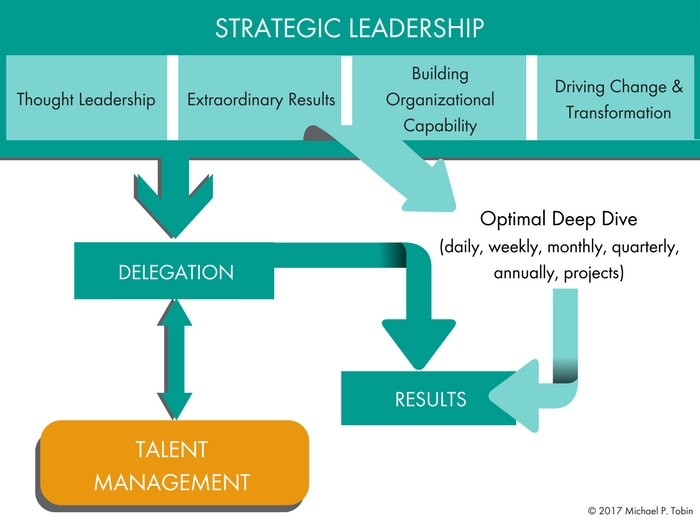Our Model of Strategic Leadership places the leader’s responsibility for building and nurturing top talent at its very core

The Model suggests that having very strong teams — comprised of top talent — is a key enabler for the leader to operate at the strategic level. That is, having a team the leader can confidently delegate to allows the leader to spend their time providing thought leadership; driving enterprise performance and growth; building sustainable organizational capability; and driving transformation: the hallmarks of strategic leadership.
From a talent perspective, this leadership approach is highly dynamic, with leaders continuously acquiring top talent externally while simultaneously identifying and accelerating the development of key internal talent to ready them for critical roles within the organization organization.
Succession Planning Is Not an Extraordinary Event
In the context of our Model, then, succession planning is not an extraordinary, one off event, but the natural outcome of good strategic leadership.
The strategic leader’s mind and activities, rather than being occupied with delivering monthly results, are focused on inspiring, developing, and holding accountable talented teams whose tasks include delivering extraordinary results.
Developing, challenging and coaching talented direct reports are accelerating behaviors of a strategic leader, including the occasional deep dive into results to add value. Such an approach to leadership will routinely build organizational capability in talent, and will, almost as a byproduct, result in some differentiated talent emerging to succeed the leader, or be exported elsewhere in the company.
Where to Start? How To Make Succession Planning an Everyday Event
While we at Vantage advocate for integrated, comprehensive talent management processes across the organization, a good place for an individual leader to begin is with the strength of their team. Building this foundation creates the platform for broader succession planning initiatives.
While it is desirable to have rigorous assessment of each member of one’s team and to create development plans for each one; a leader can make a lot of progress by honestly answering 2 questions.
1. How confident am I delegating to each member of my team?
To get at this question, we recommend a “quick and dirty” assessment. Using a 5-point scale, with 1 being “Not Confident to Delegate” and 5 being “Very Confident to Delegate” rate each member of your team.
For individuals rated 4 or 5, delegate more to them, and hold them accountable for results. Coach them for accelerated development.
For individuals rated 1 or 2, develop transition plans for their departure.
With individuals rated 3, provide feedback, raise expectations, and give them some time (2 to 6 months) to demonstrate that you can confidently delegate to them. Otherwise, initiate separation plans.
2. Do I have a ready-now or ready-soon (less than 2 yrs) successor for myself on the team?
If you do not have a successor, hire your successor. If you do have a successor, you should be exporting talent across the organization within a couple of years.
In general, seek to upgrade your team with great talent who can advance two levels in the company. As a strategic leader, you will help build the leadership talent pool by building organizational capability in leadership talent.
Meanwhile, with a great team to empower and hold accountable for performance outcomes, you will not only consistently deliver great results, but also be free to lead at a higher level, providing thought leadership and influence to help drive enterprise performance, growth, and transformation.
Succession Planning is the Outcome of Strategic Leadership
Seen in light of our Strategic Leadership Model, then, it is no longer necessary or even accurate to view succession planning as an isolated, narrow process focused solely on CEO succession. Rather, succession planning can be viewed in a much broader, integrated way: an enterprise-wide, dynamic leadership pipeline.
Ideally modeled by the CEO, guided and facilitated by Human Resources, succession planning can become the natural outcome and goal of Strategic Talent Management as practiced routinely by the business leaders themselves as they build, develop, and accelerate the talent on their teams.

